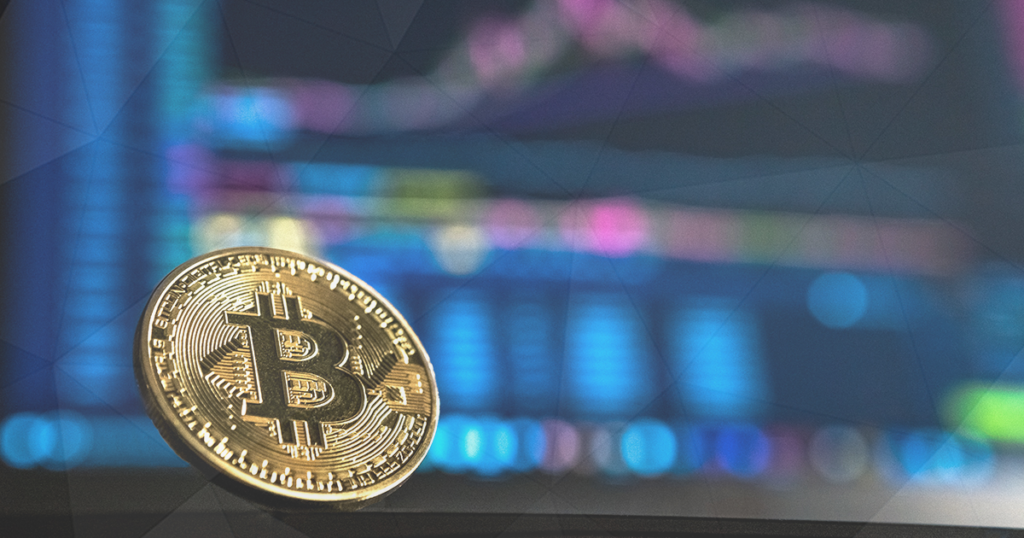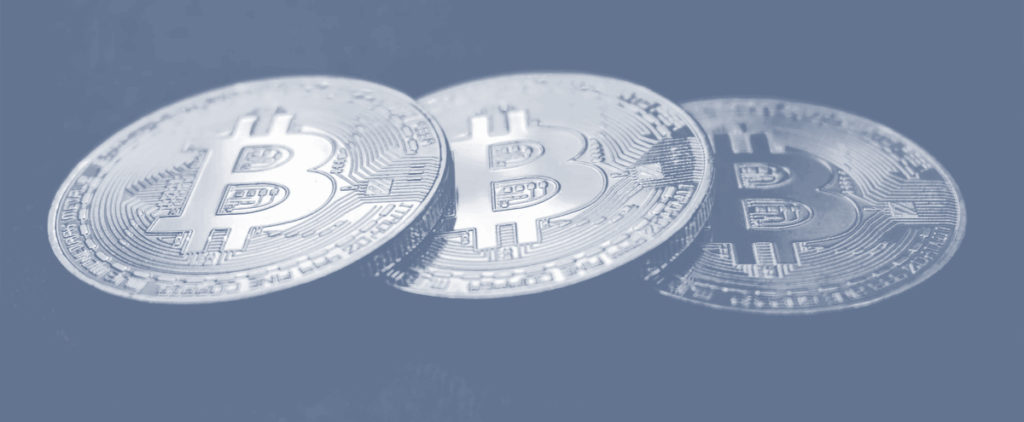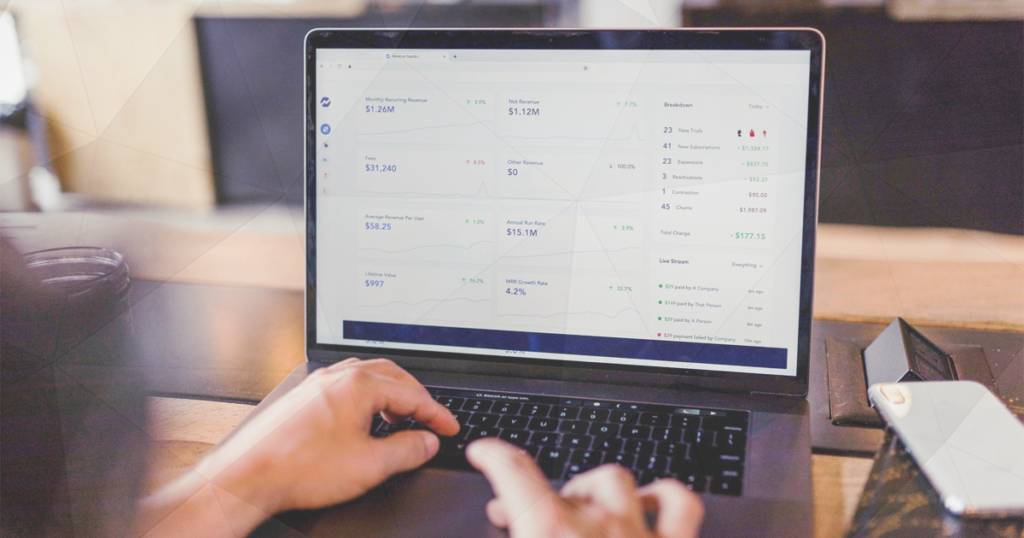Let’s Get to Grips with the Crypto Ethereum
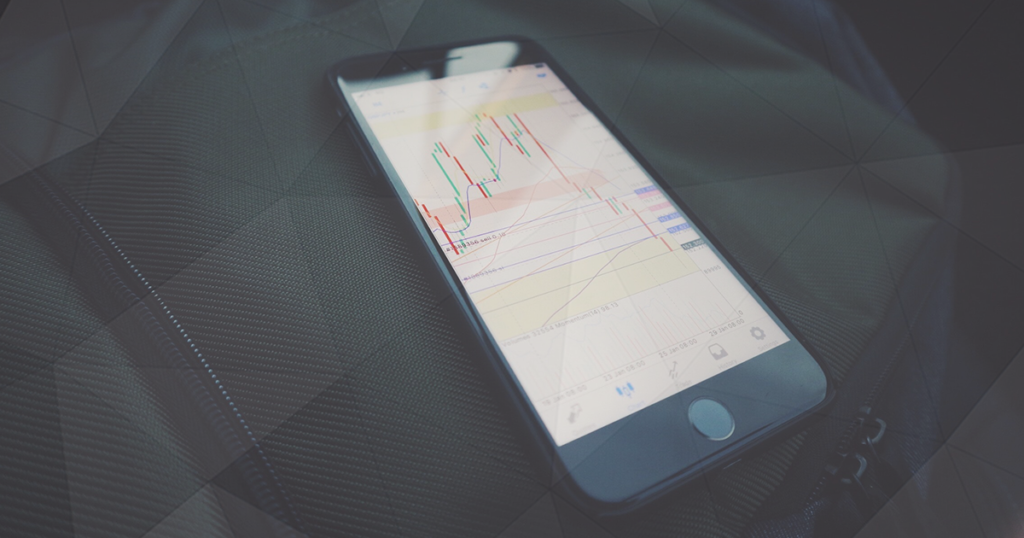
If you’ve ever heard about bitcoin, you’ve probably heard about ethereum as well. It’s one of the most used crypto-networks and currencies with the potential to deliver real-world benefits.
In this article, we’ll cover how to trade ethers (ethereum’s native currency), how the network works, what the main risks are, and what strategies you can use.
What is Etheruem?
Ethereum is an open platform that can be used to program smart contracts and DApps (decentralized apps), fueled by the network’s native cryptocurrency called ether. This means, you cannot directly trade the ethereum network, but only its tokens – ethers. Ether is the cryptocurrency that many people refer to when speaking about ethereum.
In essence, ethers are programmable bitcoins that fuel the ethereum network. The network itself is based on blockchain technology, but unlike bitcoin’s blockchain, ethereum can be programmed and used in a wide variety of applications. Just like other cryptocurrencies, ether uses a digital ledger shared among all participants in the network where all transactions are validated and recorded. The ledger can be accessed publicly and it’s almost impossible to make retrospective changes to its records.
All transactions are verified by miners, which are then grouped into blocks, cryptographically secured, and linked to the ethereum blockchain. For each verified block, the miner earns a so-called “block reward” in the form of a set number of ethers.
The ethereum blockchain is a very powerful platform with numerous potential applications. One of them is “smart contracts”. A smart contract is a piece of code written on the ethereum blockchain that automatically executes an agreement (e.g. a payment) as soon as pre-set conditions are met. This eliminates the delay of traditional contracts and reduces fraud to a minimum since a smart contract cannot be altered once activated.
The potential of smart contracts is almost limitless, and many startups are already using ethereum and smart contracts to revolutionise the insurance or finance industries.
Another popular use of the ethereum blockchain is the development of DApps, which stands for decentralised applications. Just like smart contracts, DApps run on the ethereum network, but unlike smart contracts, they don’t alter the blockchain. DApps can be used for a wide range of applications as they aren’t confined to purely financial uses.
Read:
What are Key Chart Levels? (And How to Trade Them Effectively)
Easy to Understand Price Action Trading
And How to Enter Price Action Trades like a Pro
What Impacts Ether’s Price?
Since traditional fundamental analysis cannot be performed on cryptocurrencies, ether is largely influenced by technical levels and decisions of technical traders.
The ethereum blockchain was launched in 2015, which means that traders have access to a relatively short period of historic price-data. This is also one of the main risks when it comes to applying technical analysis on ether’s price chart. Popular technical tools, such as trendlines, channels, trend analysis, technical indicators, support and resistance levels, and wave counting can be successfully applied to ether trading.
Unlike bitcoins, the total amount of ethers that can be mined is not limited. Available ethers will fluctuate as some tokens get lost and new ones get mined.
While government regulation on crypto-currencies is still quite loose, this could change soon. Owning and trading cryptocurrencies is fully legal in most countries, but some countries have put certain restrictions or prohibited the use of cryptocurrencies. Before you start trading on ethers through crypto-exchanges, make sure they are legal in your country.
Finally, as the adoption of the ethereum blockchain grows, the demand and supply for the token are set to fluctuate which can have an impact on ether’s price.
Trading Ethers Through Crypto-Exchanges
If you want to trade ethers by directly owning the cryptocurrency, the easiest way to buy ethers is through a crypto-exchange. However, before buying ethers, there are a few steps you need to follow:
Get an Ethereum Wallet
To store and hold your ethers, you’ll need an ethereum wallet. There are many types of wallets to choose from, but all of them can be grouped into two main groups: software wallets and hardware wallets.
Software wallets store ethers directly on your computer, which makes them less secure than hardware wallets. However, many popular software wallets are free and available for a wide range of devices, including desktops and smartphones. Popular software wallets for Ethereum include Exodus and MyEtherWallet.
Hardware wallets are similar to flash drives that connect to your computer and store your ethers offline, which makes them more secure than software wallets. However, hardware wallets are also more expensive than their software counterparts. TREZOR and Ledger are popular hardware wallets that support ethereum.
Buy Ethers Through an Exchange
Now that you have set up your ether wallet, it’s time to buy the actual coin. The easiest way to do so is to buy ethers through a crypto-exchange and pay with a credit/debit card or wire transfer.
Popular crypto-exchanges include Bitpanda, Coinbase, and CEX.io. Simply open an account, add your payment method, and choose the number of ethers you want to buy.
Move Ethers to Your Wallet
Finally, it’s time to move your new ethers to your personal wallet, or they’ll stay in your account on the exchange. Your wallet comes with a unique address that consists of a long string of characters, so use that address to send your ethers from the exchange to your personal wallet.
Read: 26 Ways to Become a Kick Ass Trader
Trading Ether CFDs
An alternative way to trade on price fluctuations of ether is to use CFDs or Contracts for Difference. Most traders will likely use this option to trade ethers as it comes with a number of advantages compared to buying the coins through an exchange.
What is an Ether CFD?
A Contract for Difference, or CFD, is a derivative contract that is often used for speculating on movements of financial instruments. A CFD tracks the price of the underlying instrument, which means that the CFD trader doesn’t own the underlying asset. A CFD pays the difference between the entry and exit price to your account – if the price goes in your favour, you’ll make a profit, and if the price goes against you, you’ll have a loss.
For example, if you buy a CFD on ether for $180 and sell it for $200, you’ll make a profit of $20. However, if the price drops to $160, your total loss will be $20. The advantage of using CFDs for pure price-speculation is access to leverage. Leverage allows you to open a much larger position size than your initial trading account.
You deposit $1,800 with your CFD broker. Without leverage, this would allow you to buy 10 ethers at the current market price of $180 per coin. However, with a 20:1 leverage, the total number of coins you would be able to buy would rise to 200! Bear in mind that this increases not only your potential profits but also your losses. This is why leverage is considered a double-edged sword.
Another major advantage of trading ether with CFDs instead of buying them through an exchange is the ability of short-selling. In essence, short selling allows a trader to profit when the price is falling, whereas buying ethers through exchanges gives traders only a long (buy) exposure, i.e. they only profit when the price is rising.
Short-selling works in the following way: After you identify a selling opportunity and want to sell-short ether, your broker lends you ether and you sell them at the current market price. After the price falls, you buy the borrowed ethers at the lower price and return them to your broker, making a profit which equals the difference between the selling price and the buying price. The entire process of short-selling is fully automated; you simply need to click on “Sell” and make a profit as the price falls.
However, if the price goes up, you’ll need to buy and return the borrowed coins at a higher price and take a loss. Since prices can theoretically rise to infinity (but only fall to $0), short-selling is slightly riskier than taking a long position in ether.
Ether Trading Strategies
Most crypto-traders use technical trading strategies to trade on ether or other cryptocurrencies.
The reason for this is that fundamental analysis is quite limited in the crypto-world. While traders do have access to data such as market capitalisation, news and amount of circulating currency, technical analysis has shown to return better results. This is especially true for shorter-term trading, such as scalping and day trading. We covered two of the most popular day trading strategies in the following lines – trend-following and breakout trading.
Trend-Following
Just like any other asset, cryptocurrencies like to trend. A trend can be up, down, or sideways. An uptrend forms when the price is making consecutive higher highs and higher lows (see chart below), pushing the price steadily higher. The opposite of an uptrend is a downtrend, which is formed by consecutive lower lows and lower highs, which pushes the prices lower.
Finally, if there is no trend, we say that the market is sideways trading or ranging, in which case trading support and resistance levels will provide better results than trend-following.
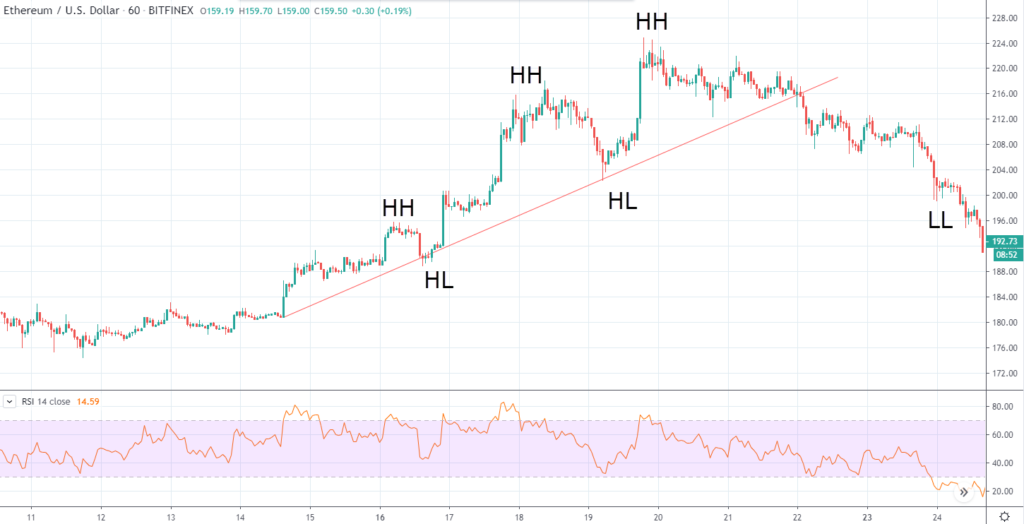
The chart above shows a short-term uptrend on the 1-hour chart which pushed the price from around $175 to a high of $225. A trend-follower could spot the first higher high (HH) and a higher low (HL), and enter with a long position at around $190.
A stop-loss could be placed just below the higher low and the trader could manually lock in profits after the price broke below the rising trendline.
Breakout Trading
Another popular day trading strategy to trade ether is breakout trading. As its name suggests, breakout traders try to catch and take advantage of price breakouts above or below important technical levels, including chart patterns, support and resistance levels, trendlines, and channels, to name a few. A breakout is usually followed by a large trading momentum as the result of stop-losses being triggered or other traders opening positions in the direction of the breakout. Breakout traders try to catch this surge in volatility and momentum.
Since breakouts happen very fast, traders who follow this trading approach often use pending orders to catch a breakout as soon as it happens.
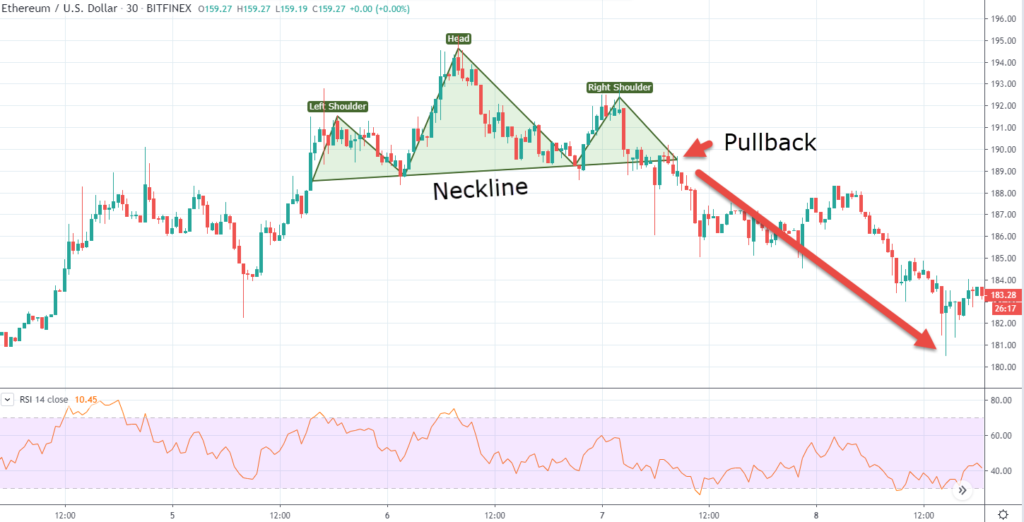
The chart above shows a breakout trade based on a bearish head and shoulders pattern on the 30-minutes chart. A selling opportunity arises when the price breaks below the neckline of the pattern that connects the lows of the “head” and the “shoulder”.
Notice the pullback in the chart – the price retested the broken neckline which now acted as a resistance for the price, sending the price significantly lower in the following hours.
In addition, check the structure of the head and shoulders pattern. Did you notice that the right shoulder is actually a lower high (a characteristic of downtrends) that formed after a long-lasting uptrend? The head of the pattern represents a higher high, and the break below the neckline signals that a lower low is inevitable.
Expert Tip: Pullbacks are a great way to enter into a breakout trade after you miss the initial breakout.
Read: Why Stop Losses are Incredibly Important (And How to Use Them)
Final Words
Since its launch in 2015, the ethereum network has exponentially grown in popularity to become a serious competitor of Bitcoin. Ethereum’s token is called ether, which is the actual cryptocurrency that provides access to ethereum’s services, including smart contracts and DApps (decentralised apps.)
There are two main ways to participate in the ethereum revolution: You can either buy actual coins through exchanges or trade on ether by using CFDs.
While both approaches have their advantages and disadvantages, we feel that using CFDs provides more benefits if you want to trade on shorter-term price moves. In addition, CFDs also allow you to increase your purchasing power by utilising leverage and to profit from falling prices by short-selling ethers.

